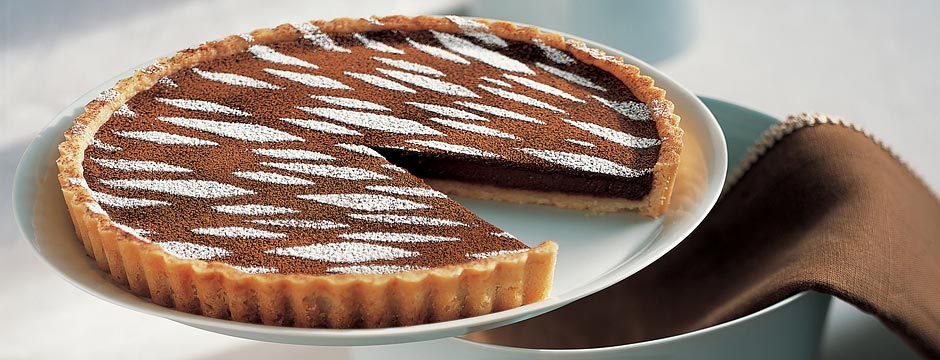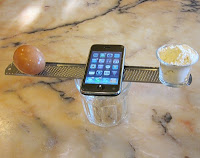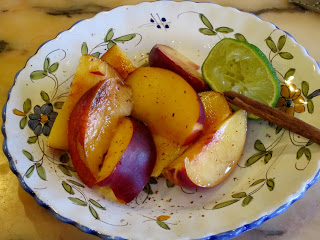I had a last minute email from the folks at Scharffen Berger Chocolate asking for an alternate version of the chocolate cupcake recipe that I created for the Scharffen Berger Tutti Foodie 2010 Chocolate Adventure Contest website (
www.chocolateadventurecontest.com). The alternate version would call for unsweetened chocolate instead of cocoa powder, and it was needed almost immediately (don’t ask…). Hmmph.
Meanwhile, I had to drive from Berkeley to Cupertino at rush hour. I thought I’d pass the time by listening to NPR (of course) and thinking about how to revise the original (and really good) recipe.
Such a revision starts with simple math to figure out how much unsweetened chocolate would be needed to replace the 1 ½ ounces of cocoa in the recipe and to figure out how to adjust the amount of butter in the recipe to account for the increase in fat from the unsweetened chocolate. The cocoa is about 22% fat and 78% pure non-fat cocoa and unsweetened chocolate is a little over 50% fat. Had I been at home, I would have written a simple equation and used a calculator. I’ve always like math…
But in the car? I was pretty sure that using my Iphone calculator while driving was as dangerous as texting. So I decided to round off the ingredient stats so I could do the math in my head, easily and without killing anyone. I would treat the cocoa as though it were fat free and the unsweetened chocolate as 50% fat. Then it was easy to figure out that I would need 3 ounces of unsweetened chocolate to get the effect of 1 ½ ounces of cocoa powder. But substituting 3 ounces of unsweetened chocolate for 1 ½ ounces cocoa would also add 1 ½ ounces of fat to the recipe. I could compensate by subtracting 1 ½ ounces (3 tablespoons) of butter from the original 8 tablespoons in the recipe. Easy so far.
I was still driving impeccably, but the time had passed so quickly and pleasantly that I feared I might have driven past the Dumbarton Bridge without noticing. Where was I anyway? Uh oh. But no, Fremont comes before the bridge; I was still on track
I drifted back to my cupcakes (while staying scrupulously in my own lane of course). I began to think about how the texture might change from using chocolate instead of cocoa powder. Cocoa butter (which is the fat in the chocolate) melts at a higher temperature than regular (dairy) butter, and I would be replacing some regular butter with cocoa butter. This might produce a heavier, coarser crumb and a seemingly drier texture because cocoa butter takes longer than regular butter to melt on your tongue. My original cupcake was light, tender and moist—exemplary of the advantages of using cocoa instead of chocolate. What to do? Still driving safely, I decided to trade just a little of the butter for vegetable oil to counteract the harder cocoa butter. I arrived in Cupertino with a good mental draft of my revised recipe. I hadn't run anyone off the road either.
I tested the new cupcakes at home (as yet I have no oven or mixer in my car) and found them to be excellent. I didn't need to change a thing! Even I was amazed.
Later, out of curiosity (and yes, like a dog with bone), I sat down with a calculator and did the math accurately. It’s a good thing I decided to drive safely, because rounding off the ingredient stats resulted in my using more chocolate than I otherwise would have and conjuring up a terrific new recipe with only one real test! What more could I ask? Scroll down to see the original recipe and the Safe Driver’s Revision followed by a recipe for the frosting.
Are there morals to this story? 1. Doing the math is always helpful but you don’t always have to be perfectly accurate 2. It’s always good to consider what you know about the ingredients because math is not enough, and 3. You always have to test. Oh, and 4. Never text, use a calculator, or test a recipe while driving.
Want to learn more about formulas and strategies for converting recipes from one type of chocolate or cocoa to another? Check out the Dessert Makers’ Guide to Working with Chocolate, page 344, of my book, Bittersweet: Recipes and Tales from a Life in Chocolate (Artisan, 2003).
SCHARFFEN BERGER CHOCOLATE CUPCAKES
These are light, tender, moist, chocolaty, and so easy to make. The Safe Drivers’ Revision follows, and after than you'll find the frosting recipe. Make the frosting first and it will be almost ready to use by the time the cupcakes are baked and cooled.
Ingredients:
1 cup (4.5 ounces) all purpose flour
1 cup plus 2 tablespoons (7.3 ounces) sugar
1/3 cup plus 2 tablespoons (1.5 ounces) Scharffen Berger Unsweetened Natural Cocoa Powder
1/2 cup (1 stick or 4 ounces) unsalted butter, melted and warm
1 teaspoon pure vanilla extract
Equipment:
1 regular (not jumbo) cupcake pan with 12 cups, lined with paper liners
A hand held electric mixer or stand mixer with the whisk attachment (if you have a choice)
Position a rack in the lower third of the oven. Preheat the oven to 350 degrees.
In a large mixing bowl, mix the flour, cocoa powder, sugar, baking soda, and salt together thoroughly. Add the butter, eggs, and vanilla and beat on medium speed for one minute. Add half of the water and beat for 20 seconds. Scrape the sides of the bowl and add the remaining water. Beat for 20-30 seconds until the batter is smooth. The batter will be thin enough to pour. Divide it evenly among the lined cups. Bake 18-22 minutes (rotating the pan from front to back half-way through the baking time), just until a toothpick inserted into a few of the cupcakes comes out clean. Set the pan on a rack to cool for ten minutes. Transfer the cupcakes from the pan to the rack and let them cool completely before frosting or filling. Store and serve at room temperature. Makes twelve cupcakes
TIP: For light tender cupcakes, spoon flour and cocoa lightly into measuring cups (instead of dipping the cups into the flour or cocoa) and then sweep the measures level without tapping or shaking them. Better still, use your scale.
SAFE DRIVERS' AKA SCHARFFEN BERGER CHOCOLATE CUPCAKES 2.0
This version calls for unsweetened chocolate instead of cocoa and a little oil in addition to the butter.
Ingredients:
1 cup (4.5 ounces) all purpose flour
1 cup plus 2 tablespoons (7.3 ounces) sugar
3 ounces 99% Unsweetened Scharffen Berger Chocolate, coarsely chopped
3 tablespoons (1.5 ounces) unsalted butter
2 tablespoons vegetable oil
1 teaspoon pure vanilla extract
1 regular (not jumbo) cupcake pan with 12 cups, lined with paper liners
A hand held electric mixer or stand mixer with the whisk attachment (if you have a choice)
Position a rack in the lower third of the oven. Preheat the oven to 350 degrees.
Melt the chocolate and butter in a stainless steel bowl set directly in a wide skillet of almost simmering water. Set aside.
In a large mixing bowl, mix the flour, sugar, baking soda, and salt together thoroughly. Add the very warm chocolate mixture, oil, eggs, and vanilla and beat on medium speed for one minute. Add half of the water and beat for 20 seconds. Scrape the sides of the bowl and add the remaining water. Beat for 20-30 seconds until the batter is smooth. Divide the batter evenly among the lined cups. Bake 18-22 minutes (rotating the pan from front to back half-way through the baking time), just until a toothpick inserted into a few of the cupcakes comes out clean. Set the pan on a rack to cool for ten minutes. Transfer the cupcakes from the pan to the rack and let them cool completely before frosting or filling. Store and serve at room temperature. Makes twelve cupcakes
TIP: For light tender cupcakes, spoon flour lightly into measuring cups (instead of dipping the cups into the flour) and then sweep the measures level without tapping or shaking them. Better still, use a scale!
SCHARFFEN BERGER CHOCOLATE FROSTING
For the smoothest and glossiest frosting, allow it to cool and thicken slowly at room temperature (without stirring) while you make your cupcakes!
Ingredients:
3 ounces unsweetened Scharffen Berger 99% unsweetened chocolate, coarsely chopped
4 tablespoons (1/2 stick or 2 ounces) unsalted butter, cut into several pieces
2/3 cup heavy cream
2/3 cup sugar
1/8 teaspoon salt
Place the chocolate and butter in a medium bowl and set aside. Bring the cream, sugar, and salt to a simmer in a large saucepan. Simmer for 4 minutes, stirring frequently. Pour the hot cream over the chocolate. Whisk just until the chocolate is completely melted and the mixture is smooth and glossy. Set aside to cool at room temperature, without stirring for 2 to 3 hours, or until the frosting is cool and thick enough to spread. Or, refrigerate the frosting for about 45 minutes or more (but not until it is hard) without stirring, then let it stand at room temperature until it is the desired consistency. Makes about 1-1/2 cups of frosting




